
Yangon
In nearly every Myanmar tour,Yangon is usually the first and foremost stop as it is the country’s must-visit tourist attraction, most bustling commercial hub as well as largest city with its area of nearly 600 square kilometers and population of about 4.4 million. Before being replaced by Nay Pyi Daw in late 2005, the city was Myanmar’s capital. Nowadays, it is the main gateway to Myanmar – via airway, waterway, and road.
- Location: Yangon region, heart of Lower Myanmar
- Status: Myanmar’s former capital
- Population: 4,348,000 (2010 census)
- Area: 598.75 square km
- Religions: Buddhism, Hinduism, Islam, Christianity
- Myanmar’s largest city and most significant commercial centre
Originally, Yangon was the small village of Dagon, and later in 1755 conquered by Alaungpaya King who changed it into Yangon, meaning “end of strife”. After being captured and returned by British in the First Anglo-Burmese war (1824-1826), in 1841, the city was destroyed in a fire. In the Second war in 1852, it was brought to life again under a new identity – British Burma’s political and commercial centre. In 1885 when the entire Burma was seized British colony in the Third Anglo-Burmese war, Yangon became the official capital of British Burma. By gaining its independence from Britain in 1948, Burma has developed quickly, especially Yangon. With green covering the land, cool weather, tropical trees along two roadsides, many green parks and beautiful lakes, Yangon is known as the garden city of the East.
The best time to visit Yangon is January-February
Yangon is a place lots of people visit almost all year round, but if you’re looking for the best time to go, January-February is definitely the time you should visit. This is based on a number of factors such as the weather, cost of flights and accommodation, peak travel periods and more.
The very hottest temperatures in Yangon get to around 41℃ (105℉) in the height of summer. In the winter, temperatures can get down to 19℃ (67℉) around January.
The sun stays up the longest in Yangon in April, so you’ll get the most out of your daytime activities if you visit around this time. The wet season in Yangon usually falls during the months surrounding August each year. It’s not uncommon to get some decent rainfall or light showers during this time, but on some days the weather tends to be fine for a majority of the day, with only a few drops of rain falling from a passing shower.
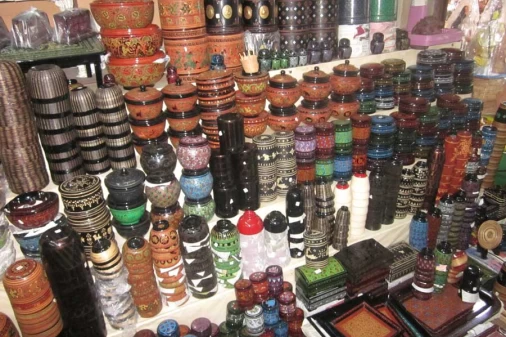
Bogyoke Aung San Market
Bogyoke Aung San Market is situated in the heart of Yangon. on Bogyoke Aung San Road. The name of this...
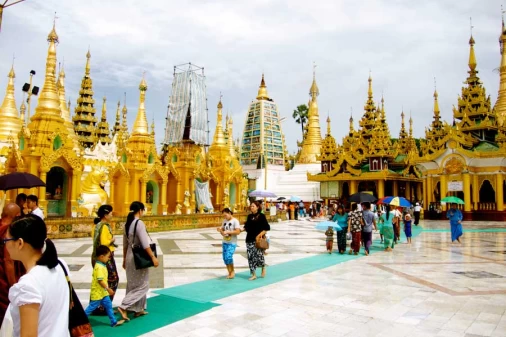
Botatatung Paya
The Botataung Pagoda is located on the Botataung Paya Road. which was named after the Pagoda. It is...
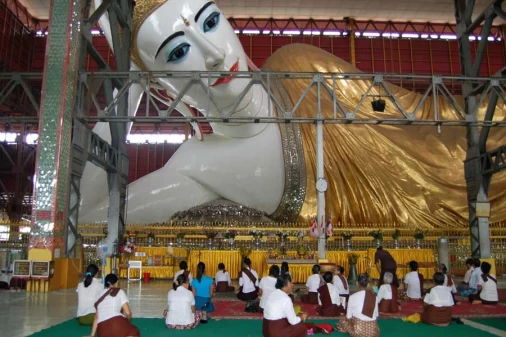
Chaukhtatgyi Paya
One of Myanmar’s more revered reclining Buddhas. It is housed in a large metal-roofed shed, only a short...
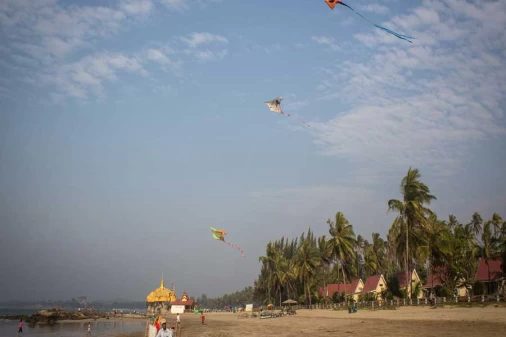
Chaungtha
Descriptions: From the mountains, to the cities, along the rivers, through the crop fields, over the...
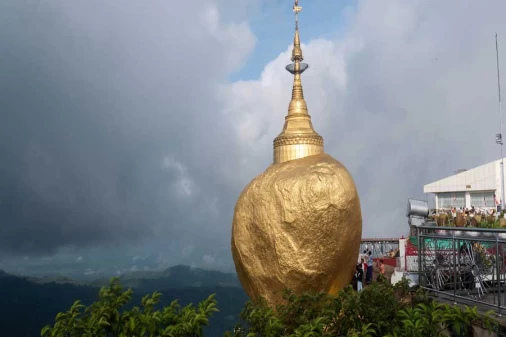
Golden Rock / Kyaiktiyo
Descriptions: Kyaikhtiyo Pagoda, known to the west as “Golden Rock,” perches on the edge of a cliff...
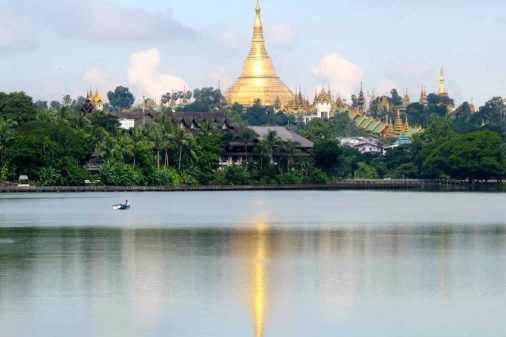
Kandawgyi Park and Lake
Dubbed ‘The Garden City of the East,’ Yangon is suitably surrounded by lush tropical gardens and leafy...
Frequently asked questions
1. Shwedagon Pagoda
Description:
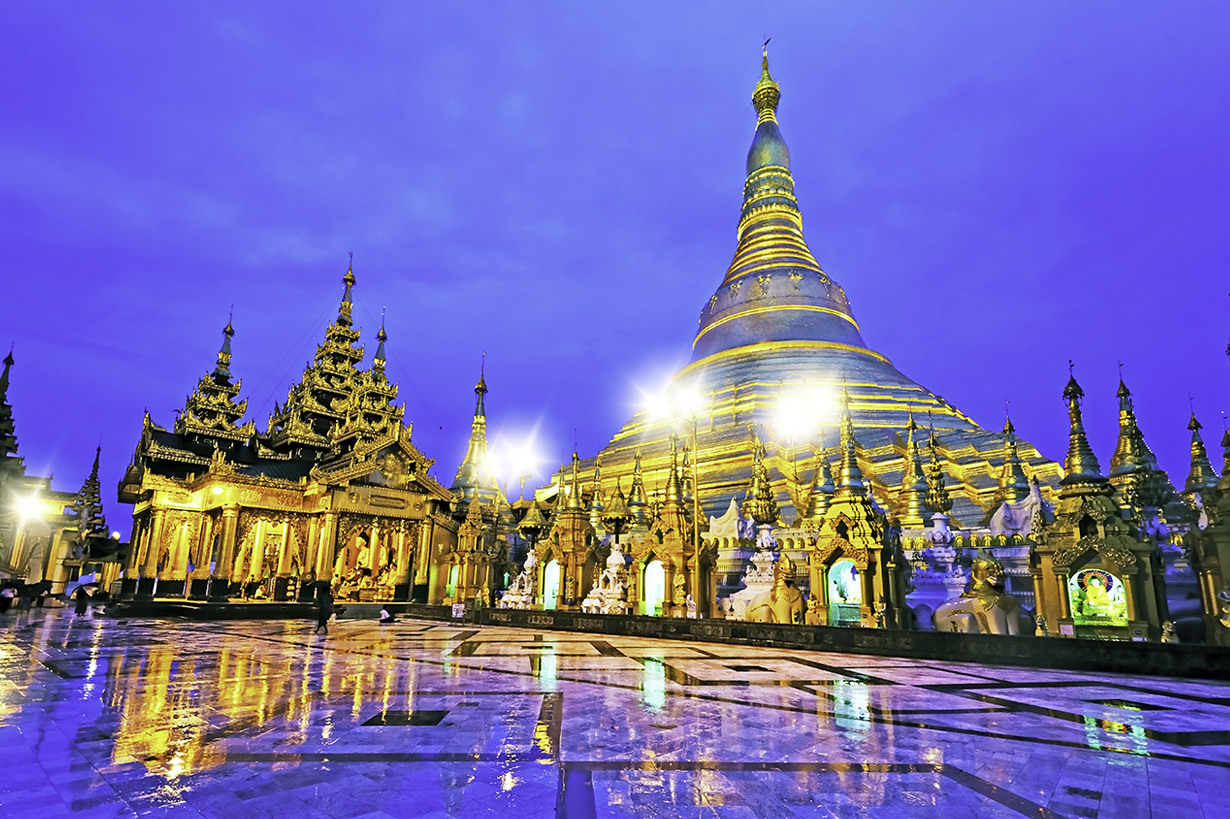 While roaming around the city of Yangon a very tall golden pagoda may have caught your eye. This is the most famous pagoda, Shwedagon, in all of Myanmar. Built in the 6th century B.C. Shwedagon is said to hold eight strands of Buddha’s hair. It is a place of worship for the local people and an amazing site for non-locals. With thousands of Buddha images and hundreds of monks wondering around the temple, it is surely to touch your heart and soul. The pagoda also provides and excellent view of the city and its surroundings. You can easily spend a few hours gazing up at the gold covered tower, as well as exploring the different and lavishly decorated buildings within the complex. Shwedagon also has a lot of history within its walls.
While roaming around the city of Yangon a very tall golden pagoda may have caught your eye. This is the most famous pagoda, Shwedagon, in all of Myanmar. Built in the 6th century B.C. Shwedagon is said to hold eight strands of Buddha’s hair. It is a place of worship for the local people and an amazing site for non-locals. With thousands of Buddha images and hundreds of monks wondering around the temple, it is surely to touch your heart and soul. The pagoda also provides and excellent view of the city and its surroundings. You can easily spend a few hours gazing up at the gold covered tower, as well as exploring the different and lavishly decorated buildings within the complex. Shwedagon also has a lot of history within its walls.
No visit to the Union of Myanmar is complete without a visit to the 2,500 years old Shwedagon Pagoda, which enshrines strands of Buddha’s hair and other holy relics. Located west of the Royal Lake on 114 -acre Singuttara Hill in Yangon, Shwedagon Pagoda is the most sacred and impressive Buddhist site for the people of the Union of Myanmar. From a humble beginning of 8.2 meters, the Shwedagon Pagoda today stands close to 110 meters. Shwedagon Pagoda is covered with hundreds of gold plates and the top of the stupa is encrusted with 4531 diamonds; the largest of which is a 72 carat diamond. It is clearly one of the wonders of the religious world. Shwedagon Pagoda is a repository of the best in Myanmar heritage – architecture, sculpture and arts. The Shwedagon Pagoda consists hundreds colorful temples, stupas, and statues that reflects the architectural era spanning almost a 2,500 years. To understand this monumental work of art and architecture, visitors will experience an insider’s view of this magnificent symbol of Buddhism to the lives of the Myanmar people. Shwedagon Pagoda forms the focus of religious as well as community activities – the bustling of devotees and monks washing the statues, offering flowers, worshiping, and meditating. Shwedagon Pagoda is administered by the Board of Trustees of Shwedagon Pagoda.
2. Kyauk Thar Gyi Pagoda
Description
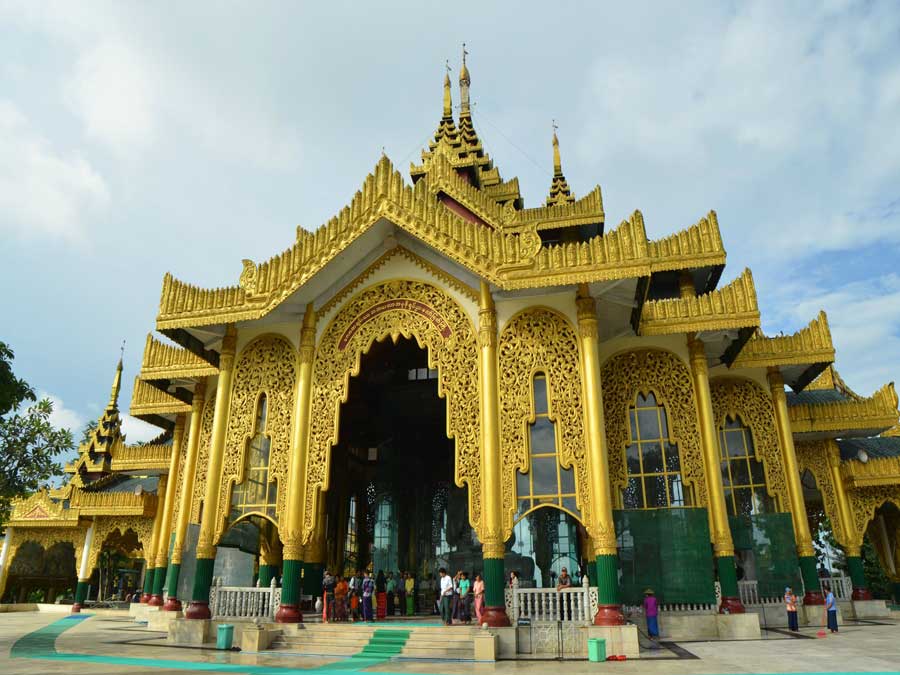 Chauk Htat Gyi Pagoda is located on Shwe Gon Taing Road. Tamwe Township. Yangon. Similar ones are Ngar Htat Gyi Buddha (5-Storey-High Buddha) and Koe Htat Gyi Buddha (9-Storey-High Buddha). Chauk Htat Gyi is the 6-Storey-High Buddha Image.
Chauk Htat Gyi Pagoda is located on Shwe Gon Taing Road. Tamwe Township. Yangon. Similar ones are Ngar Htat Gyi Buddha (5-Storey-High Buddha) and Koe Htat Gyi Buddha (9-Storey-High Buddha). Chauk Htat Gyi is the 6-Storey-High Buddha Image.
The Chauk Htat Gyi Pagoda is famous for its huge image of Reclining Buddha. built in 1966 replacing the old image built in 1907 by Sir Hpo Thar. But it was suffered damage due to climate over the years. In 1957 it was demolished and rebuilt to this structure in 1966. It measures 65 meters and is housed in an iron structure with corrugated iron sheets roof of six layers.
Hence it is generally referred to as the six-tiered pagodas. The heavy cost of this construction was entirely donated by the people. The image is larger than the image of the Reclining Buddha at Shwe Thar Hlyaung Pagoda in Bago.
The monasteries in the vicinity of this pagoda accommodate over six hundred monks who study Buddhist Scriptures from the senior and qualified monks. The entire cost of maintenance is met from the people’s donations.
Here within the old metal roofed shed you will find one of the larges reclining Buddha images in all of Southeast Asia. This temple is a must see while touring around Yangon, and it is just a short distance from Shwedagon pagoda. You’re sure to be impressed by its massiveness. If you are into fortune telling then you have come to the right spot. There are quite a few astrological and palm readers within the temple. If you’re impressed by this Buddha and would like to see one a bit bigger we suggest a day trip to Bago.
3. Sule Pagoda
Description
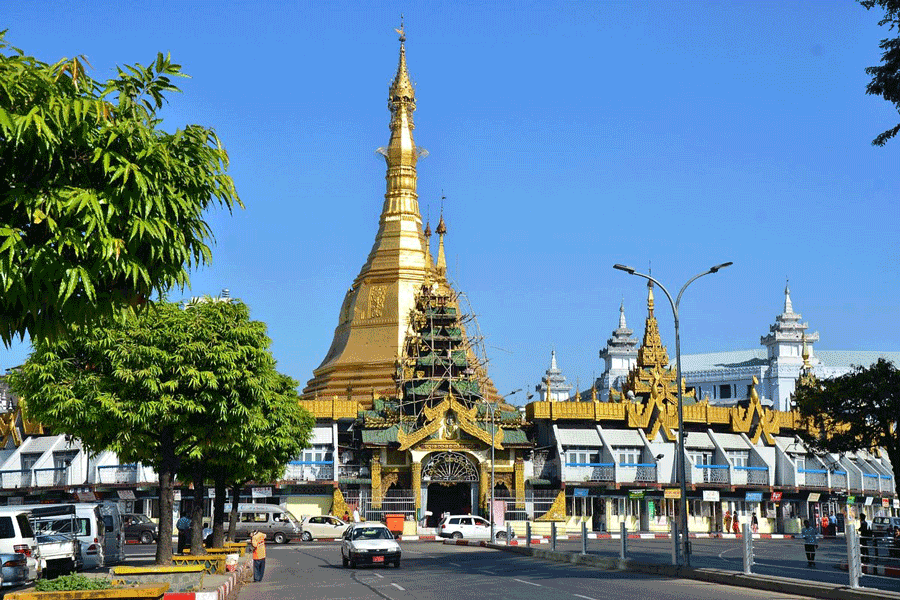 Sule Pagoda is located in the center of Yangon. at the junction of Sule Pagoda Road and Mahabandoola Road. Kyauktada Township. Yangon. Myanmar. This 48 meter (152 feet) high golden dome was used by the British as the nucleus of their grid pattern for the city when it was rebuilt in the 1880s.
Sule Pagoda is located in the center of Yangon. at the junction of Sule Pagoda Road and Mahabandoola Road. Kyauktada Township. Yangon. Myanmar. This 48 meter (152 feet) high golden dome was used by the British as the nucleus of their grid pattern for the city when it was rebuilt in the 1880s.
The pagoda’s peculiarity is its octagonal- shaped pagoda. which retains its shape as it tapers to the spire.
The Sule Pagoda is an excellent landmark. It is said to be over 2.000 years old. The pagoda is said to enshrine a hair of the Buddha: its Mon name. Kyaik Athok translates as “the pagoda where a Sacred Hair Relic is enshrined”. The golden pagoda is unusual in that its octagonal shape continues right up to the bell and inverted bowl. It is surrounded by small shops and all the familiar non-religious services such as of astrologists. palmists. and so on.
In the downtown area Sule Pagoda is a monument which most foreign visitors pass by unnoticed. But it is the only central piece of the capital. like the Arc de Triumph in Paris.
It is the Sule Pagoda. Its legend says that Sule Pagoda marks the site where King Ukkalapa held meetings to build Shwedagon. “Su-Wei” is a Myanmar word meaning “meeting”. In course of time ‘Su-Wei’ corrupted to ‘Su-Le’ Successive town planners. King Thayawaddy. Montgomery. Fraser and others. all decided to keep Sule Pagoda as the centre piece of Yangon because of its strategic location. religious significance and artistic beauty. It can be reached through four entrances of the four stairways facing four cardinal directions or by two overhead bridges.
4. National Museum
Description
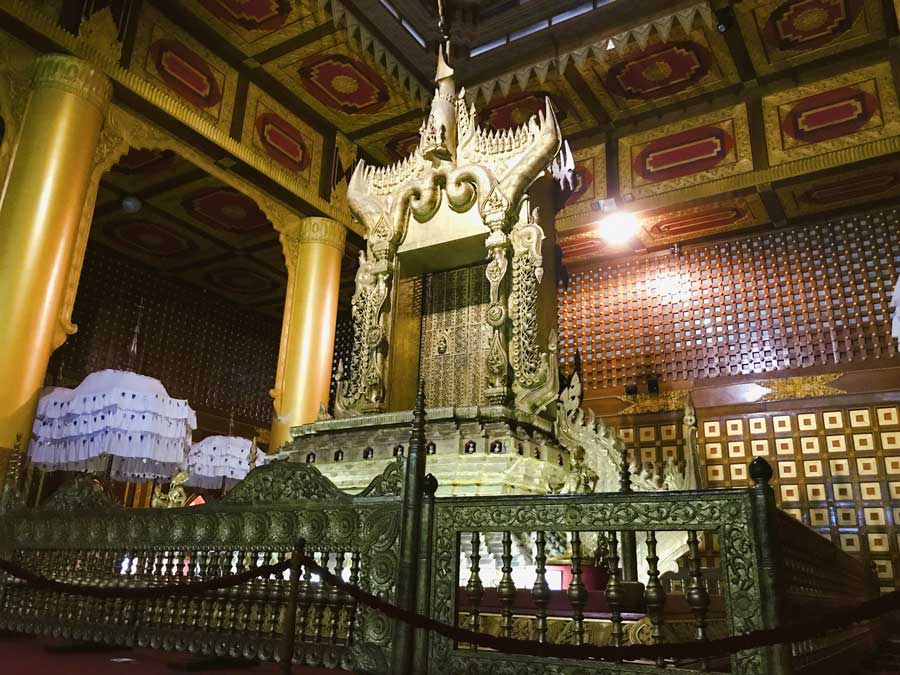 National Museum of Myanmar is located at No. 66/74. Pyay Road. Dagon Township. Yangon. Myanmar. The National Museum of Myanmar was founded in 1952 with its premises at what was once the Jubilee Hall. In 1970 the museum was moved to a more spacious building on Pansodan Street. But these premises were not originally constructed to house a museum. The present National Museum is located on Pyay Road in a splendid five-storey building constructed for the purpose in spacious and specially landscaped grounds. Priceless ancient artifacts. works of art and historic memorabilia are on display in 14 halls on four storeys. Three halls on the ground floor hold exhibits on the evolution the Myanmar script and alphabet. the Lion Throne Room and Yatanabon Period pieces.
National Museum of Myanmar is located at No. 66/74. Pyay Road. Dagon Township. Yangon. Myanmar. The National Museum of Myanmar was founded in 1952 with its premises at what was once the Jubilee Hall. In 1970 the museum was moved to a more spacious building on Pansodan Street. But these premises were not originally constructed to house a museum. The present National Museum is located on Pyay Road in a splendid five-storey building constructed for the purpose in spacious and specially landscaped grounds. Priceless ancient artifacts. works of art and historic memorabilia are on display in 14 halls on four storeys. Three halls on the ground floor hold exhibits on the evolution the Myanmar script and alphabet. the Lion Throne Room and Yatanabon Period pieces.
GROUND FLOOR
One can study the origins of the Myanmar alphabet. Myanmar script and literature as well as those of the other national races of Myanmar. There is also an interesting stone funerary urn of the period AD1 – AD 9 with Pyu writings on it in this hall.
In the throne room you will see miniature models of the eight kinds of thrones of ancient Myanmar kings and the magnificent Royal Lion Throne of our last monarch King Thibaw in all its original majesty. This great throne is made of smooth-grained “Yamanay” timber adorned with lions at its base. The whole throne is heavily gilded. This throne is always placed in the “Hluttaw” Hall. (the Hall of the Council of Ministers). The king uses this throne when deliberating with his ministers on state affairs or delivering judgments on important issues.
In the 19th century Yadanabon Period Exhibit hall one can see clothing fashions. furniture and other household articles of the time. There is also a palanquin used by king Thibaw’s Chief monk. It has a gilded roof with three spires.
FIRST FLOOR
On the first floor of the museum are four halls. one with an impressive display of the royal regalia. a second hall with exhibits of historic significance; the third hall with exhibits of pre-historic times and the fourth containing exhibits on natural history. In the hall of the royal regalia one can see beautifully ornamented objects that played a significant role in important royal ceremonies of ancient kings throughout Myanmar history. An example of the high standard of craftsmanship is the royal betel box in the shape of a Brahminy (Hamsa) bird. It is a beautifully gilded box embedded with valuable gems.
In the hall of Myanmar history are the pagodas. temples. monasteries and ordination halls of the Bagan Period and the marvelous murals of the Pinya. Innwa. Toungoo. Nyaungyan and Konbaung Eras. One can see rare ancient votive tablets with moldings from scenes of the Jataka Stories. that is the Lord Buddha’s birth stories.
In the hall of pre-historic times is a model of the Padalin Cave which is over 10.000 years old where stone age men once dwelt and etched drawings on its walls. There are also stone weapons of the Neolithic Period and also some bronze weapons of a later age. Then. there are clay pots. urns. votive tablets and necklaces that date back to the Pyu Era that spans the period from the first century to the ninth century A.D.
Then there are rare and priceless exhibits – silver chedis (stupas) found in the archaeological excavations at the ancient Pyu city of Sriksetra. They provide material evidence that Buddhism had flourished in Myanmar as far back as the ancient Pyu Period.
In the exhibit hall on natural history are many fossils dating back millions of years. In this hall is an exhibit that is a truly rare find. It is fossil of an anthropoid primate that has been dated as being approximately 40 million years old. It was found in the Pondaung region of Upper Myanmar.
SECOND FLOOR
The second floor of the museum is where exhibits on Myanmar culture can be seen with one hall assigned to Myanmar music. song and dance.
In the hall on culture are displayed exhibits on Myanmar rural life. One can learn much of the social. economic and cultural traditions as well as modes of transportation of days gone by. One sees the Myanmar bullock cart still in use in some rural areas. The utility cart is used to transport heavy loads of paddy and other agricultural produce whereas the cart used on ceremonial occasions is a thing of beauty decorated with delicate wood carvings. The cart is very light and dainty with streamlined proportions. It is used at pagoda festivals and novitiation ceremonies when its passengers are belles of the village dressed in their best finery.
An offering bowl for monks gilded and wrought with mosaics of semi-precious stones is also on display. It is used for offering food and other comestibles to monks on religious occasions.
In the hall of music. song and dance. you will see many musical instruments and the ornate “saing waing” or drum circle as well as marionettes that can be made to dance in classical dramas and operas.
THIRD FLOOR
On the third floor of the museum are 3 exhibition halls. two for Myanmar paintings and a third for ancient ornaments and jewelry.
In the Hall of Paintings you can observe the progress of the Myanmar art of painting beginning with the cave paintings of the Stone Age and down through the Bagan. Innwa. Amarapura. Konbaung and Ratanabon periods to 20th century contemporary art. The works of famous artists are on display.
In the third hall can be seen the personal ornaments and jewelry worn by the Myanmar people since ancient times. Here you will see an ornament for the ears of the 18th century A.D. It is called a “Nadaung” in Myanmar and is a cylindrical plug which is worn by pushing it into the pierced ear lobe. It is an ancient piece of jewelry.
FOURTH FLOOR
On the fourth floor are halls for the Buddha Images and for the display of the culture of the ethnic races of Myanmar. The Buddha images include those which date back to the Pyu Period and up to the present day.
In the Hall of ethnic culture you can see a colorful display of their national dresses as well as various artifacts that they traditionally use.
The National Museum thus is a treasure chest of priceless stone inscriptions. documents. carvings. paintings and a host of other artifacts that testify to the ancient culture and civilization of the Myanmar people. Anyone who has made a tour of the museum will come away with greater knowledge and understanding of Myanmar and its people.
5. Bogyoke Market
Bogyoke Aung San Market is situated in the heart of Yangon. on Bogyoke Aung San Road. The name of this road was also named after the market. The Bogyoke Aung San Market is the most popular market and a great tourist destination in Yangon. It is one of the precious colonial buildings you can find in Yangon.
The market was first built and inaugurated on the present premises in 1926. It was named Scott Market after Mr. C. Scott. the then Municipal Commissioner. Nowadays. it is called Bogyoke Aung San Market in honour of our national leader General Aung San who was assassinated in 1947.
STRUCTURE
There are 1.641 shops selling luxury items. handicrafts. foodstuffs. clothing. jewelry. fashion and consumer goods. The market is a square type based and therefore divided into the East wing. West wing. North wing and South wing. The shopping items are not categorized in the respective wings. Looking around and finding the most suitable item would be fun. There are also traditional. Myanmar and Chinese food stalls in the market.
Event Bogyoke Aung San Market is also well-known for the pre-Thingyan festival also called the Zay Thingyan meaning the Market’s water festival. It is usually held on the 11th or 12th of April. Youngsters from all over the city come to the market dressed for the festival. The shops donates traditional food such as Monte Lone Yay Paw. Thargu. and Shwe Yin Aye.
NEARBY ATTRACTIONS
In front of the Bogyoke Aung San Market. there is the busy Shwe Bon Thar Street (formerly known as the Mongol Street). where most of Yangon’s popular clinics are located. Next to the Bogyoke Aung San market. there is the 9-storey FMI building. Some shops and some offices are located in that building. Then you can find the Grand Meeyatthar Housing. which is a nice place for you to stay downtown. The Traders Hotel is nearby the market. at the corner of Bogyoke Aung San Road and Sule Pagoda Road.
Day 1: Downtown Yangon
 A visit to the downtown area of Yangon is a must. Walking around Sule Pagoda, you get to experience the busy life of the Yangon people, as this is the major business district in Myanmar.
A visit to the downtown area of Yangon is a must. Walking around Sule Pagoda, you get to experience the busy life of the Yangon people, as this is the major business district in Myanmar.
Sule Pagoda is flanked by the Immanuel Baptist Church and the Bengali Sunni Jameh Mosque. As you climb up the stairs of Sule Pagoda, you can enjoy the view from the top and see Yangon in a different light. You can walk around the pagoda grounds and be in awe of this golden stupa that was built more than 2,500 years ago.
The next stop after visiting Maha Bandoola Park would have to be Rangoon Tea House restaurant in Pansodan Street where you can enjoy a sumptuous lunch. Laphet Thote is the signature Burmese dish to try.
After savouring a delicious Burmese lunch, you can enjoy a leisurely stroll along Pansodan Street. Many colonial buildings, such as Myanmar Port Authority Building, Telegraph Office, and Rangoon High Court Building, are all located on Pansodan Street.
Botahtaung Harbour is the next destination to visit. There, sit on a bench and see the labour workers toil away at the harbour. You can also get great photos of sunset from here, too.
End your first day in Yangon in the most fantastic way by visiting Shwedagon Pagoda, the ultimate landmark of Yangon. There is a mandatory $8 entrance fee for foreigners but that little amount of money for such a splendid pagoda is definitely worth it. This 105-metre golden pagoda is said to contain relics of Lord Buddha, and the Burmese people consider the Shwedagon Pagoda the most sacred pagoda of all in Yangon.
Day 2: Activities + Cathedral + Pagoda
 There is no better way to begin your day than having buffet breakfast at Shan Yoe Yar restaurant in Wartan Street. You can have one main dish (either noodle or rice of your choice) with unlimited access to fries and salads. It is also very cheap at a price of only 5,000 Kyats (approximately $4) and it is definitely worth it.
There is no better way to begin your day than having buffet breakfast at Shan Yoe Yar restaurant in Wartan Street. You can have one main dish (either noodle or rice of your choice) with unlimited access to fries and salads. It is also very cheap at a price of only 5,000 Kyats (approximately $4) and it is definitely worth it.
After experiencing the hustle and bustle at the local market, take the Yangon Circular Train to immerse yourself in more of the Burmese people’s daily lifestyle. Channel the Burmese commuter and hobnob with locals on the train. Make the most of the warmth and friendliness of the locals and capture the most organic photos of life in Myanmar. You’ll get amazing shots, too, especially since the locals do not mind having their photos taken.
Then, stop for lunch at Junction City which is located across the Bogyoke Market. While food courts were relatively unknown in Yangon, the last five years have seen a surge in the common eating rooms. One of the best things about food courts in Yangon is that their hygiene standard in food court is much higher than street shops.
After finishing your lunch, make your way to Bogyoke Market, one of the more popular tourist attractions in Yangon. There, you can buy souvenirs, such as paintings, key chains, and traditional bags. For visitors who are looking for high-end quality products, Yangoods is a popular shop that offers great products at very reasonable prices. At Bogyoke, prepare to bargain to stretch your budget. Sometimes, you can even bargain for half the price for goods, so don’t be shy to flex those negotiation skills.
After getting souvenirs for your friends and family at Bogyoke market, you can head to Saint Mary’s Cathedral, the largest cathedral in Yangon, in Bo Aung Kyaw Street. The taxi cost fare from Bogyoke Market will also be just around 1000-1500 Kyats.
Your next stop should be the Chauk Htet Kyi Pagoda. This reclining Buddha image is 65-metre long and will surely be an awe-inspiring sight. If you still have time, visit the Ngar Htet Gyi Pagoda, which is within walking distance from Chauk Htet Kyi Pagoda. This other 14-metre tall sitting Buddha image is equally as grand as Chauk Htet Kyi.
After visiting cathedrals and temples, drop in at 19th Street. The street is filled with streetside joints, local beer stations, and quaint eateries. Enjoy the barbecued foods, such as BBQ chicken, pork, or vegetables, and wash it down with a local beer. Before heading back to your hotel, get a foot or body massage at the lower block of 19th street.
Day 3: Day trips outside of Yangon
 As most part of the day will be spent on the car driving to Thanlyin, welcome the chance to stretch those muscles with a morning walk at Inya Lake. Take in the scenic views of Inya Lake as you make your way around the lake.
As most part of the day will be spent on the car driving to Thanlyin, welcome the chance to stretch those muscles with a morning walk at Inya Lake. Take in the scenic views of Inya Lake as you make your way around the lake.
After your early morning stroll, load up with some Mohinga, a local favourite breakfast. before heading off to Thanlyin. Mohinga, a fish soup usually served with rice noodle, is prepared in a hot bowl and you can enjoy it in the classiest style by adding as much fries into the soup as you would love to. Fried gourd, fried Mandalay beans, and fried dough sticks are just examples of fried food options that you can add into your bowl of hot Mohinga.
You can rent a taxi service to travel to Thanlyin for only $80. and it usually takes about two hours to get there. Once in Thanlyin, make a pit stop at Yele Kyauktan Pagoda. Perched on the river, you have to ride a boat to cross to this pagoda’s grounds.
For the lunch, you can stop at a local toddy palm juice shop to eat and drink like a local. Toddy palm juice is a popular local liquor in the outskirts of Yangon, and you can down it with some grub, like fried crunchy bean salad, or if you are an adventurous eater, you can try fried rat (or frog).
Then, drop in for a visit to the ancient Portuguese Church. This place has gotten popular in the recent years, thanks to the rustic look of weathered structures and overgrown greens. Thanlyin, unlike Yangon which is ruled by British colony, was ruled by the Portuguese and this ancient ruin of Portuguese Church is the evidence that Thanlyin used to be a Portuguese-occupied territory.
The trip back to downtown Yangon takes about two hours, and if you still have time, I would advise you to visit the Yangon Gallery to see some of the city’s popular works of art. Develop an appreciation for local artistry.
1.Mohinga (Fish Soup)
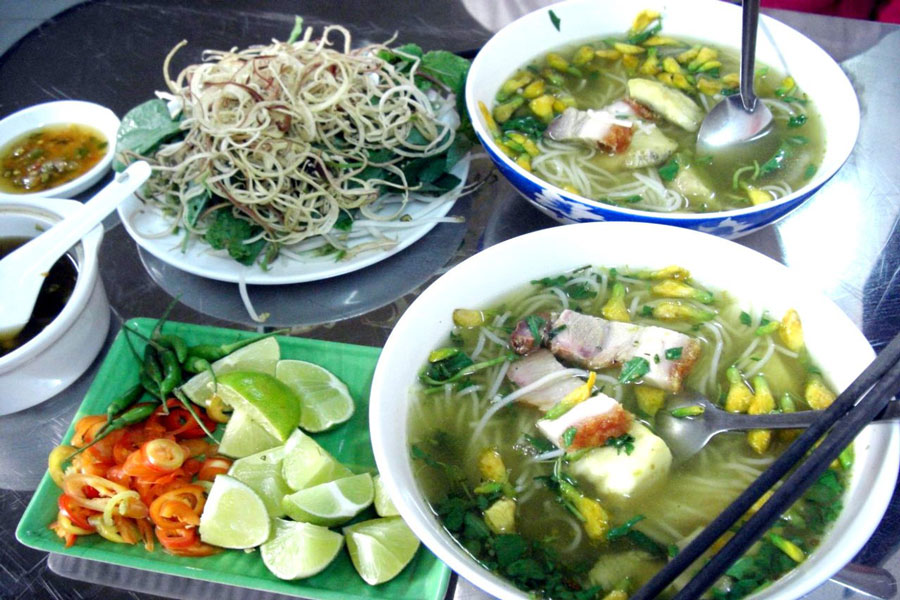 This is considered the national dish of Myanmar and is normally eaten in the morning for breakfast. I agree that fish soup does not sound like the most appealing dish for breakfast, but this was hands down my favorite meal in Myanmar. It tasted nothing like fish and oddly reminded me of corn flakes.
This is considered the national dish of Myanmar and is normally eaten in the morning for breakfast. I agree that fish soup does not sound like the most appealing dish for breakfast, but this was hands down my favorite meal in Myanmar. It tasted nothing like fish and oddly reminded me of corn flakes.
It was a warm bothy soup that is thickened with chickpea flour and comes with rice noodles, a boiled egg, onions, garlic, chilis, and fried corn fritters.
They call it fish head soup, but depending on what region you are in, it doesn’t always come with fish. As I said, it tasted nothing like fish. Grab a bowl on the streets in the morning and enjoy it with locals before they head to work.
2. Shan Noodles
 Another super popular dish all throughout Myanmar. Even though this dish comes from the Shan region of Myanmar, it is widely eaten throughout the whole country. This was another brothy noodle dish that I ate almost every day throughout my time in Myanmar.
Another super popular dish all throughout Myanmar. Even though this dish comes from the Shan region of Myanmar, it is widely eaten throughout the whole country. This was another brothy noodle dish that I ate almost every day throughout my time in Myanmar.
It can be served with or without meat and is served for breakfast, but locals tend to eat this one all day long. The broth is not as thick as mohinga, but the flavors are mouth-watering and you can also enjoy it without the broth. Most places will let you build your own dish, picking out just how many noodles you want and anything else you want to add.
You cannot leave without trying this dish!
3. Skewers- BBQ
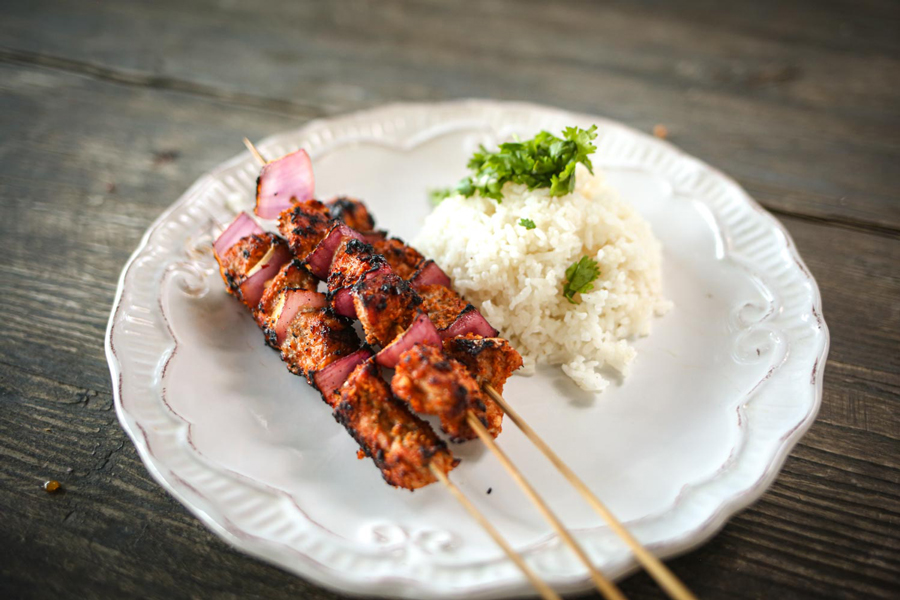 Nothing beats street food like good old fashioned BBQ, and in Yangon there is plenty to be had. It’s hard to walk down a street and not see BBQ and skewers around every corner. However, in Yangon, 19th street is probably the most popular with the tourists.
Nothing beats street food like good old fashioned BBQ, and in Yangon there is plenty to be had. It’s hard to walk down a street and not see BBQ and skewers around every corner. However, in Yangon, 19th street is probably the most popular with the tourists.
If you want to avoid the tourist crowd, head down to any other street and you will find Myanmar BBQ. Just select what you would like to eat and you pay per skewer.
This way you can eat as much or as little as you would like. Most skewers are around $1 – $2, but it depends on the cut and kind of meat you pick out. Enjoy the true BBQ culture and wash it down with a $1 Myanmar beer.
4. Ohn No Khaut Swal (Coconut Noodle Soup)
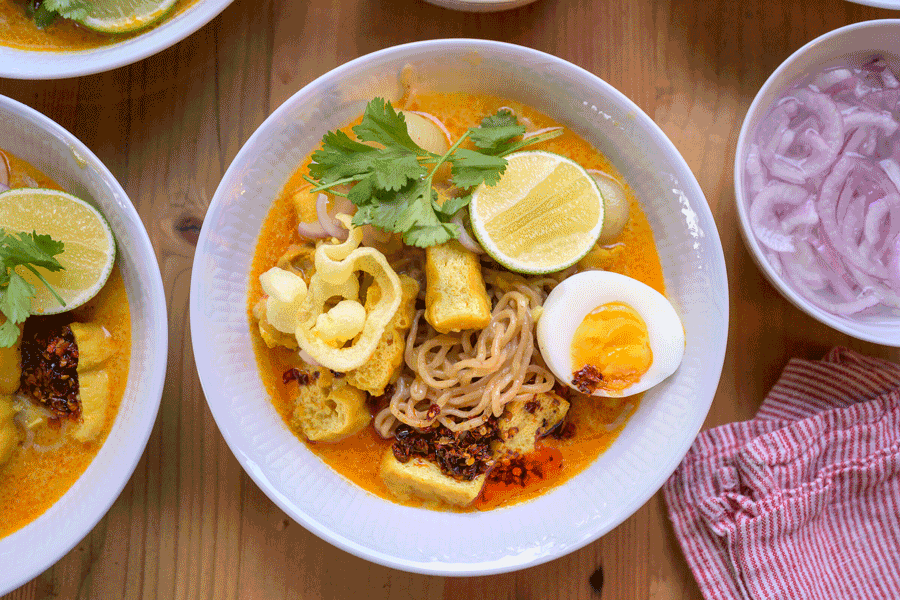 This was probably my second favorite dish I had in Myanmar, just after the Mohinga. I absolutely loved this delicious dish! It reminded me of a coconut noodle dish they have in Northern Thailand, but thankfully it was not as spicy. This was probably the first dish I had in Yangon that wasn’t overwhelmingly spicy.
This was probably my second favorite dish I had in Myanmar, just after the Mohinga. I absolutely loved this delicious dish! It reminded me of a coconut noodle dish they have in Northern Thailand, but thankfully it was not as spicy. This was probably the first dish I had in Yangon that wasn’t overwhelmingly spicy.
The creamy coconut broth was seasoned just perfectly, not too spicy and not too sweet. It also came with real noodles compared to the rice noodles that are served in most other dishes. It comes with lime, cilantro, and crispy corn fritters to give it a little crunch and texture.
5. Mote Lin Ma Yar
 I couldn’t get enough of these little guys. Crispy on the outside and gooey on the inside. They make the perfect snack for when walking around the streets of Yangon. Made with a coconut batter, fermented chickpeas and green onions on the inside.
I couldn’t get enough of these little guys. Crispy on the outside and gooey on the inside. They make the perfect snack for when walking around the streets of Yangon. Made with a coconut batter, fermented chickpeas and green onions on the inside.
The batter is poured into small little balls in hot oil of a cast-iron skillet, just enough to cook the outside crispy. They are then flipped to cook the other side, creating small little balls with a juicy dough inside. They are the perfect afternoon snack to tide you over and a nice treat if you are tired of noodles.
6. Lahpet Thoke (Fermented Tea Leaf Salad)
 This was quite a unique and interesting taste, especially compared to the other dishes I had while I was in Myanmar. I have never heard of eating tea leaves before, but since I was in Myanmar, I wanted to eat like a local. When the tea leaves are harvested, most are dried to make tea. However, in Myanmar, some of the leaves are kept fresh.
This was quite a unique and interesting taste, especially compared to the other dishes I had while I was in Myanmar. I have never heard of eating tea leaves before, but since I was in Myanmar, I wanted to eat like a local. When the tea leaves are harvested, most are dried to make tea. However, in Myanmar, some of the leaves are kept fresh.
They then ferment the tea leaves along with cabbage to make a salad. The tea leaves still have a caffeine effect. Since you are eating them and not drinking them, you the effects of the caffeine more intensely. This salad gives you energy! Along with the fermented tea leaves, they mix tomatoes, roasted peanuts, fried garlic and of course lots of chilis.
7. Myay Oae Mhee Shay (Clay Pot Noodles)
 It is hard to go a day in Myanmar without eating some sort of noodle dish. It took me about 3 weeks before I started getting sick of noodles because they are able to do this dish in many unique ways.
It is hard to go a day in Myanmar without eating some sort of noodle dish. It took me about 3 weeks before I started getting sick of noodles because they are able to do this dish in many unique ways.
The clay pot noodles were different because they were a thick rice noodle, whereas most of the other dishes were a thin rice noodle. Since they were cooked in a clay pot it tended to be a heavier dish, almost more like a pasta with an Asian taste to it. For this particular dish you had your choice of either chicken or pork.
8. Fried Chicken
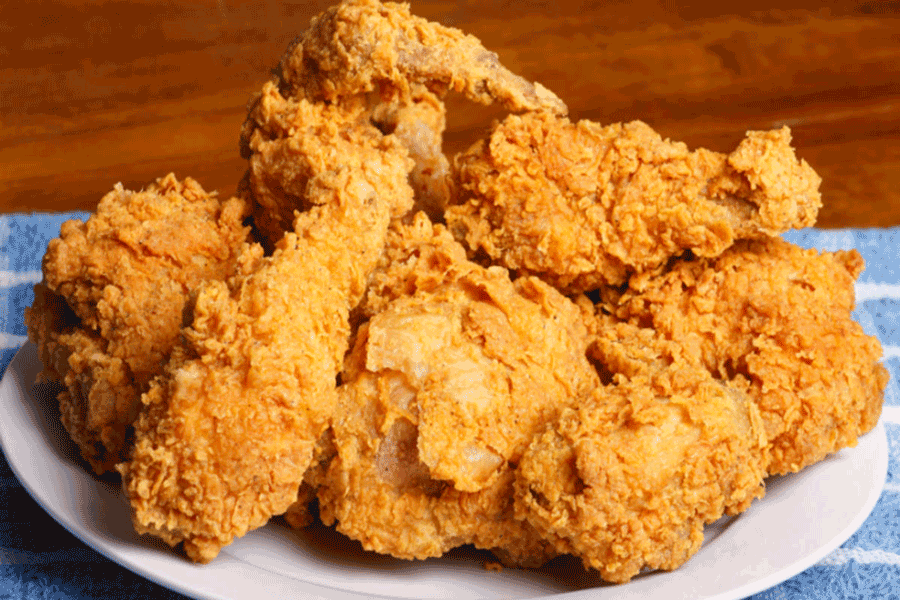 Yangon has some of the best street food around, and their fried chicken is mouth-watering good. It was so easy to pick some up while you walked around town looking at pagodas and checking out the circular train. Plus one piece of chicken was typically under $1.
Yangon has some of the best street food around, and their fried chicken is mouth-watering good. It was so easy to pick some up while you walked around town looking at pagodas and checking out the circular train. Plus one piece of chicken was typically under $1.
It is hard to understand how KFC is even in Yangon when you can find this chicken everywhere. The fried chicken on the street is served with a sweet chili sauce, which gives it just the right combination of spicy and sweet. It is so crispy on the outside and nice and juicy on the inside.
If you are in Yangon, don’t forget to try their fried chicken. They will also give you fried chicken skin as you wait for your chicken to cook.
9. Steamed Bao Buns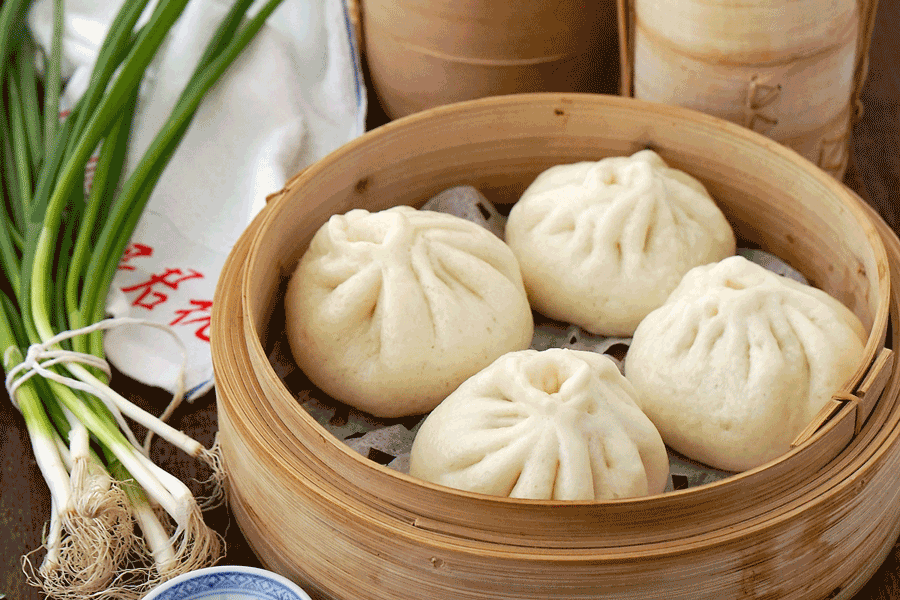 You can find these pillows of love all through-out Myanmar. When you are eating out at a local restaurant, they will put them on your table while you wait for your food. Know that you will be charged, but only if you eat them.
You can find these pillows of love all through-out Myanmar. When you are eating out at a local restaurant, they will put them on your table while you wait for your food. Know that you will be charged, but only if you eat them.
They also sell them on every street corner and in all convenient stores. You can’t miss them and you must try them. They make a great snack or a meal on their own. LIght fluffy dough on the outside, and perfectly seasoned pulled pork or chicken on the inside.
10. Samosas
 Myanmar has an interesting blend of cuisine. It is highly influenced by Asia, but also India. When you are tired of its Asian influence, enjoy the Indian side.
Myanmar has an interesting blend of cuisine. It is highly influenced by Asia, but also India. When you are tired of its Asian influence, enjoy the Indian side.
Yangon had some of the best street samosas around. Samosas are a potato curry wrapped in a light dough and then deep-fried. They are not too spicy, so if you are looking for that extra kick, eat them with some fried chilis. They were so good and so cheap, I made sure to eat them every day.
If you are still unsure of what to eat in Yangon, Myanmar, just get out and walk the streets. You will find tons of locals enjoying the cuisine, they will point you in the right direction.
I always follow the locals when I am traveling and eat where they eat. Not only does this ensure you eat at the best places in town, but it’s also how you save money. Locals don’t eat where the food is overpriced, and they especially don’t eat where the food isn’t tasty. Follow the locals and you will be safe.
Looking for something else to do in Myanmar? Make sure you check out the trekking from Kalaw to Inle Lake
Myanmar experiences a mainly tropical climate, which can basically be divided into three distinct seasons. Lying in the south of Myanmar, Yangon remains relatively warm throughout the year. Generally, the best time to go visit Yangon is during the cool season from November to January when it is much cooling and relatively low rainfall.
Yangon Festivals
 Yangon’s summer runs from March to May. November to January is comfortable, with highs in the low 30s and lows in the low 20s. Winter is the tourist season – particularly around Chinese New Year – when you are most likely to encounter fellow travelers. However, while the period between June and November is considered rainy, showers are short and can be easily worked around. One of Yangon’s largest festivals is the Shwedagon Festival celebrating the country’s largest pagoda. It follows the lunar calendar and is in February or March.
Yangon’s summer runs from March to May. November to January is comfortable, with highs in the low 30s and lows in the low 20s. Winter is the tourist season – particularly around Chinese New Year – when you are most likely to encounter fellow travelers. However, while the period between June and November is considered rainy, showers are short and can be easily worked around. One of Yangon’s largest festivals is the Shwedagon Festival celebrating the country’s largest pagoda. It follows the lunar calendar and is in February or March.
Lying in the south of Myanmar, Yangon remains relatively warm throughout the year. Generally, the best time to go visit Yangon is during the cool season from November to January when it is much cooling and relatively low rainfall. Yangon’s summer runs from March to May.
If you do want to experience the unique festivals celebrated in Myanmar, especially Yangon, it means that you have to choose your travel dates accordingly to coincide with the festive seasons. Do take note that the festivals are keyed to the lunar cycle, specifically to the full-moon days of each lunar month, and therefore fall on different days each year of the Western, solar-based, calendar.
The two main festival in Yangon is the Thingyan (Myanmar Buddhist New Year) in April during Myanmar New Year and the Shwedagon Festival
The lunar month of Tabaung brings the annual Shwedagon Festival, the largest Paya pwe (pagoda festival) in Myanmar. The full moon day in Tabaung is also an auspicious occasion for the Construction of new payas, and the local paya festivals are held. The full moon day of Tabaung is when there are special alms offerings to monks and fairs are held at the temples.
Throughout this article, we wish you to have an idea of how to travel to Myanmar for your best experience. In case you are looking for your own travel agent, who can offer a wonderful and hassle-free trip to Myanmar, please feel free to let us know. We always commit our best to make it your once-in-a-lifetime journey.
You may also like
Discover Yangon
- Depart Time:Daily
- Starts/Ends:Yangon/Yangon
- Tour type:Private Tours
- Travel Style:Family Tours, Culture & History
- Activities:Local culture tours, Cultural, religious and historic sites tours, Countryside and village visits tours
- Suitable for:Solo, Family, Group, Couple
- Age range:1 To 90 Years
- Operated in:English, French, Spanish, German, Italian
Myanmar Great Legends
- Depart Time:Daily
- Starts/Ends:Yangon/Yangon
- Tour type:Private Tours
- Travel Style:Nature & Adventure, Heritage Tours, Culture & History
- Activities:Local culture tours, Cultural, religious and historic sites tours, Countryside and village visits tours
- Suitable for:Solo, Family, Group, Couple
- Age range:1 To 90 Years
- Operated in:English, French, Spanish, German, Italian
The Best of Myanmar
- Depart Time:Daily
- Starts/Ends:Yangon/Yangon
- Tour type:Private Tours
- Travel Style:Nature & Adventure, Heritage Tours, Culture & History
- Activities:Local culture tours, Cultural, religious and historic sites tours, Countryside and village visits tours
- Suitable for:Solo, Family, Group, Couple
- Age range:1 To 90 Years
- Operated in:English, French, Spanish, German, Italian
 France
France  Spain
Spain  German
German  Italian
Italian 




 Vietnam Tours
Vietnam Tours  Cambodia Tours
Cambodia Tours  Myanmar tours
Myanmar tours  Thailand Tours
Thailand Tours  Laos Tours
Laos Tours